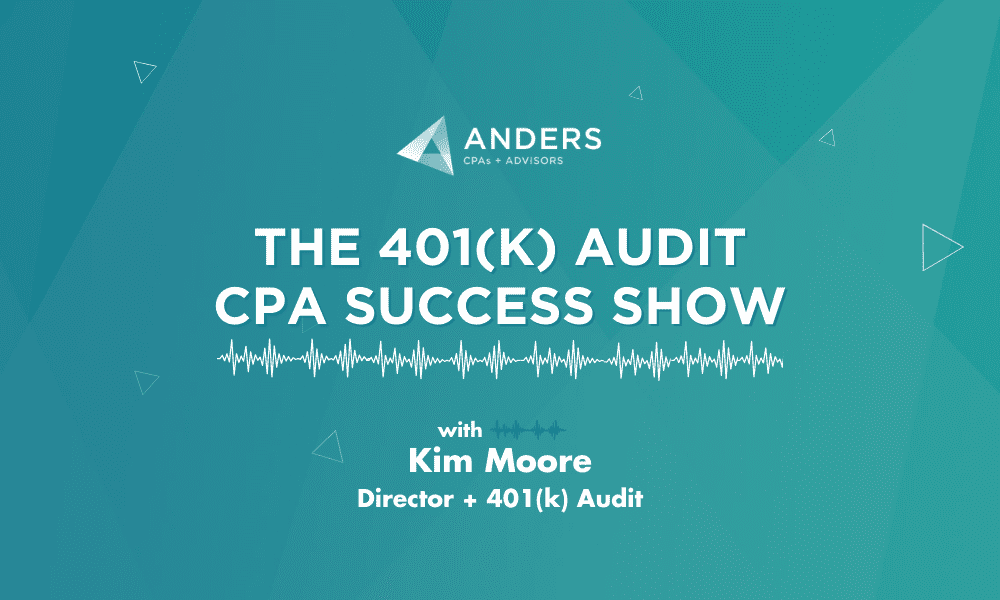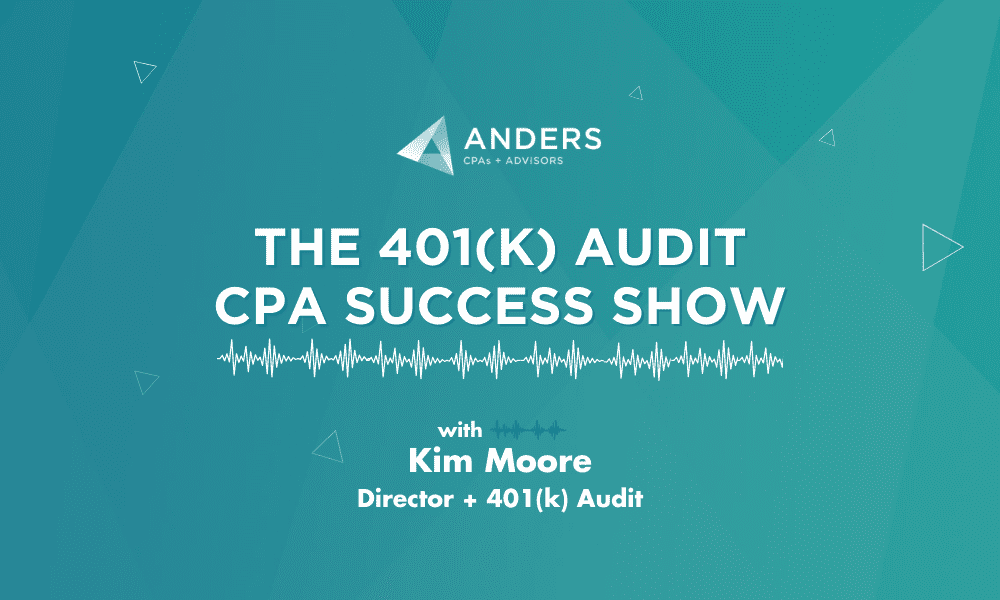As a new year approaches, 401(k) plan sponsors and administrators should begin planning for 2023 to maximize plan participation and minimize compliance risks. CPAs and Anders 401(k) auditors Kim Moore and Karen Hill explained how plan sponsors could encourage employee participation, how to better optimize a plan for higher levels of participation as well as innovative ways to ensure compliance with federal requirements.
Key Takeaways:
- First time 401(k) audits trigger upon an organization reaching 120 employees and this audit is typically more expensive than the ones that follow
- Fidelity bonds are a federal requirement that generally cover 10% of plan assets up to a maximum of $500,000
- Maintain copies of payroll reports going back several years, as well as other type of documentation, in case of an audit
- Encouraging plan participation through various methods (improving the plan, automatic enrollment, etc.) can lower an organization’s tendency to fail compliance testing
Key Steps for Audit Preparation
If your organization’s 401(k) plan has never been audited, follow the 80/120 rule. If you currently have between 80 and 120 participants; it may be time to prepare for your first audit. Plan participants include past employees with money left in the plan as well as employees who are eligible but have elected out of the plan.
The key number that triggers audits is 100 plan participants, but an audit isn’t required until an organization goes over 120 plan participants. If your company has never been audited, and you currently have between 80 to 120 employees, and you filled out a short form 5500 the year before, you can still file under short form until your organization goes over 120.
Regardless of whether it’s your organization’s first audit or the latest of many, it’s vital to begin researching audit firms early. Waiting until the last minute to find an auditor for the first time or to replace a longtime auditor following a retirement or reassignment as auditor schedules fill up quickly. Include auditing costs while planning for next year’s budget. First time audits typically cost more than those that follow.
Review Fidelity Bonds
In order to determine the value of the fidelity bonds your 401(k) plan requires, examine where your plan assets were on January 1, 2020. The general rule is that fidelity bonds must cover 10% of the plan assets up to a maximum amount of $500,000. There’s a minimum of $10,000 for very small plans, but if there’s an audit involved, the assets are likely well over the minimum amount.
If you already have a fidelity bond, make sure it’s renewed and has a built-in escalation clause. If not, make sure you renew the bond for the proper amount. Escalation clauses can add a bit more to the cost, but their benefits are very valuable, and they can help plan sponsors avoid compliance issues.
Remember that these bonds are based on asset value, so fluctuating markets could affect the measurement of the plan assets. These bonds are good protection that are well worth the slight extra cost, not to mention the fact that they’re a federal requirement.
What’s Required for Year-End Reports
A year-end report can seem overwhelming, but advanced preparation and a document retention policy can make the process much easier and more streamlined. Consider maintaining a copy of the year-end payroll report from previous years as they could be needed for a variety of audits, including 401(k), IRS or insurance audits.
Year-end payroll reports should cover the entire year, not just the final payroll. It also needs to include all employees and their compensations The different types of compensation, deductions and different types of deductions, in addition to net pay for individual employees and totals at the end of the report for the entire company.
If your organization uses a third-party administrator to manage your 401(k) planning, consider requesting payroll reports and storing them within your company’s systems for safe keeping. Should your organization choose to switch providers for any reason, it can be difficult to regain access to that information.
Open Enrollment Opportunities
Open enrollment is the ideal opportunity to review your company’s 401(k) investment lineup. Are there a variety of options that offer different types of investments, like short term, long term, high risk and low risk investments? Are there too many options? Too many options can cause confusion. Consider involving an investment advisor to help guide you through these options. An investment advisor can also keep employees educated about their 401(k) and other investment options.
Autoenrollment to Increase Plan Participation
An overall high rate of participation in the plan, even if highly compensated people are adding to the plan, can make it so the plan has a lower tendency to fail compliance, discrimination and other testing. One way to encourage plan participation is through autoenrollment.
As the name implies, this method automatically signs up eligible employees at a predetermined percentage, typically around 3%. Participants can opt out or unenroll if they choose to do so but plans that use autoenrollment generally see extraordinarily high levels of participation, close to 100% by some estimates even without a company match program.
This may not be a useful method to organizations with a high rate of turnover or a high number of non-salaried workers. The administrative burden rises in those cases, as employees may terminate yet leave small amounts of money in their accounts that now need to be disbursed.
When in Doubt, Please Reach Out
Always feel free to reach out to auditor or service provider with questions or requests for additional information. If there’s even a hint of confusion as to what an auditor is requesting, it’s best to reach out immediately and ask for clarification. Making assumptions can cause various testing to either pass when it shouldn’t or to fail when it should have passed. Failing to clarify what was requested can also result in having to redo work or resubmit paperwork.
These delays can make paperwork late, resulting in possible fines for the company and unexpected tax liabilities for plan holders. Unfortunately, the people who typically fail these tests tend to be higher-level individuals, like the company owner, senior management and board members. Leaving them to face the consequences of your mistake can be very costly.
If you need an audit for your 401(k) plan, consider a specialized firm like Anders CPAs + Advisors. We can provide a quality benefit plan audit that is efficient and accurate.
To get started, request a free 401(k) audit consultation below or contact the team at (314)-886-7913 to schedule an appointment.
Watch the 401(k) Audit CPA Success Show: Final Year-End Preparations for 401(k) Plan Sponsors on YouTube and subscribe on Spotify or Apple Podcasts and let us know what you think by rating and reviewing.
All Insights


